Last week was the first in a mini-series looking at internet access in libraries, and overall figures about who is – and isn’t – using the internet.
As highlighted, the digital divide all too easily risks becoming a development divide. Those who cannot get online risk missing out on the services and opportunities that are there, and so being left behind.
Meanwhile, when there is access, the internet can be a means for those who might otherwise be marginalised or disadvantaged to improve their situation.
This situation has become all the more acute with the COVID-19 pandemic, with many in-person services closed or seriously limited.
Last week’s publication therefore looked at internet access by household income, and whether the existence of public libraries offering internet access correlated with a smaller gap.
It found that, outside of Central and Eastern Europe, there is indeed a link – more public libraries offering internet access per 100 000 people tended to be associated with a lower hap in internet use between richer and poorer households.
This week, we’ll look at two other factors often associated with digital divides – age and gender. These are key issues, as in many societies, women and older workers can risk enjoying fewer opportunities. For them, internet access can be a valuable way of overcoming the challenges they may face.
Once again, the basis for this analysis is the OECD’s database on ICT Access and Usage by Households and Individuals, with data mainly coming from 2019. Meanwhile, data on the number of public and community libraries offering internet access comes from IFLA’s Library Map of the World.
First of all, it is worth looking at the state of the age- and gender-related digital divide. Graphs 1a and 1b do this.

Graph 1a looks at the age-related divide. In this, the higher the red bar, the greater the divide between younger (16-24) and older (55-74) people is. Only four countries indeed have a gap of less than 10 points – Denmark, Sweden, Switzerland and the United States. Three have a gap of over 50 points – Mexico, Portugal and Turkey.
In general, the divide between younger and older women is larger than that for the population as a whole, with the exceptions of Australia, Chile, Finland, Hungary, Lithuania, Sweden and the United States.
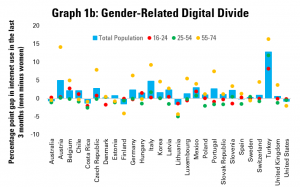
Graph 1b looks at gender digital divides, with a higher blue bar indicating a bigger divide in favour of men, and a smaller (or negative) one a better situation for women. In the population as a whole, gender digital divides are relatively small – only Austria and Turkey have gaps of over five percentage points. Australia, Costa Rica, Finland, Lithuania, Spain and the United States in fact have a greater share of women (aged 16-74) accessing the internet than of men.
However, there is a much more varied picture when we break this down by age. While in general, the gender digital divide is smaller (or more favourable for women) among younger people (aged 16-54), there is a more significant gap between older men and older women (aged 55-74). Indeed, it is only in Finland, Hungary, Lithuania and the United States where women aged 55-74 are in a more favourable position than the female population (16-74) as a whole.
Overall, these graphs underline the scale of the challenge in many countries in order to ensure that older people and women are able to get online. So how does the size of these gaps compare with numbers of libraries offering internet access? In each of the bellow graphs, each dot represents a country for which data is available.
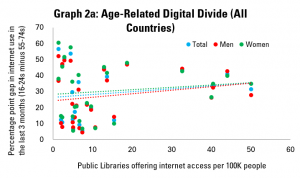
Graph 2a compares the figures from Graph 1a with Library Map of the World data on libraries offering internet access. It shows that there seems to be little relation between the presence of libraries and the age-related digital divide – or even a slightly positive correlation – i.e. more libraries are associated with a digital divide.
However, as last week, it seems appropriate to look separately at the situation for libraries in Central and Eastern Europe (a region which has had a very specific experience in the last 30 years), and other countries for which we have data. Graphs 2b and 2c do this.

Looking at this data, the correlation is completely inversed. Graph 2b shows figures for countries outside of Central and Eastern Europe, and demonstrates a relatively strong link between having more libraries offering public internet access and a smaller age-related digital divide. The link is indeed stronger for women than for men.
Overall, it appears that in general, for every extra 1 library offering internet access per 100 000 people, the age-related digital divide drops by 2.5 percentage points.
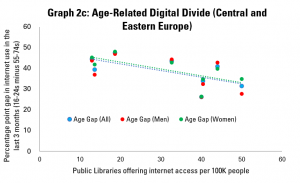
Within Central and Eastern Europe also (Graph 2c), there is also a correlation indicating that more access to internet in public libraries means a smaller age-related digital divide.
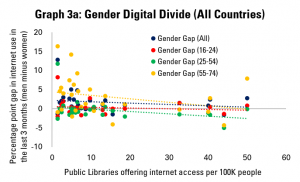
Next, we look at the gender digital divide. Graph 3a looks at the data for all countries, and shows a small correlation between more public libraries offering internet access, and smaller gender digital divides. The connection appears strongest among the older groups – 25-54s and 55-74s.
Again, we can also break up this data between Central and Eastern Europe and the rest – this is shown in Graphs 3b and 3c.
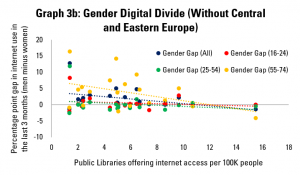
Once more, we see stronger correlations when looking at countries outside of Central and Eastern Europe (Graph 3b), in particular for older people (aged 55-74). For this group, one additional public library offering internet access tends to be associated with a 0.6 percentage point drop in the digital gender divide (in favour of women). Nonetheless, for all age groups, more public libraries tends to be associated with a smaller gender divide.
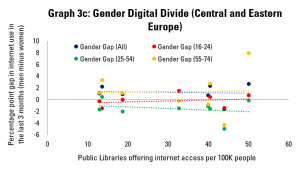
Meanwhile, looking specifically at countries in Central and Eastern Europe (Graph 3c), there is little relationship between numbers of public and community libraries offering internet access and the gender digital divide.
As ever, correlation does not mean correlation, underlining the value of more focused research onto the relationship between the availability of libraries providing internet access and digital divides. The data also clearly poses interesting questions about the situation in Central and Eastern Europe.
Nonetheless, overall, there is a welcome indication that in countries where there are more public and community libraries offering internet access, groups which can tend to be more at risk of marginalisation face smaller digital divides.
Next week, we will look at the impact of different levels of education on internet use, and whether access to libraries can help close gaps.
Find out more on the Library Map of the World, where you can download key library data in order to carry out your own analysis! See our other Library Stats of the Week! We are happy to share the data that supported this analysis on request.